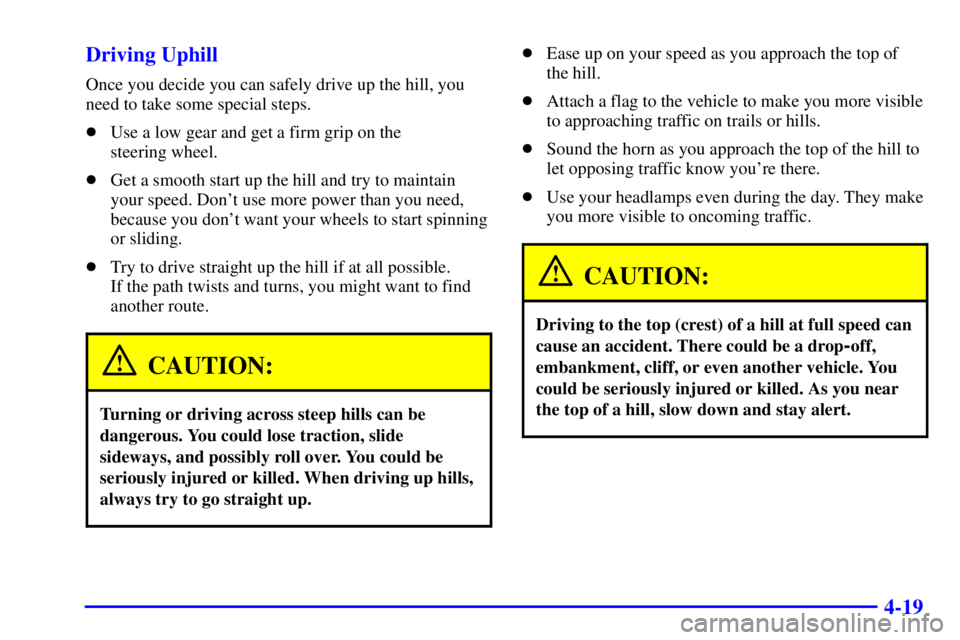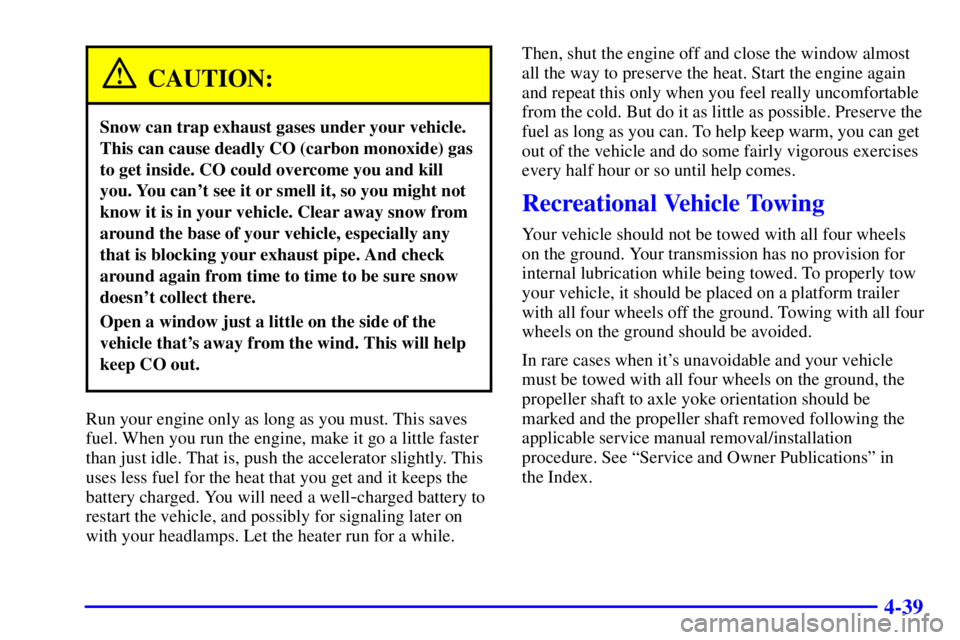Page 120 of 407

2-49 Dome Lamps
The dome lamps will come on when you open any door.
You can also turn the dome lamps on by turning the
thumbwheel, located next to the parking/headlamps
knob, all the way up to the second notch. In this
position, the dome lamps will remain on whether a door
is opened or closed.
You can use the DOME OVERRIDE button, located
below the parking/headlamp knob, to set the dome
lamps to come on automatically when any door is
opened, or to remain off. To turn the lamps off, press the
button into the ªinº position. With the button in this
position, the dome lamps will remain off when any door
is opened. To return the lamps to automatic operation,
press the button again and return it to the ªoutº position.
With the button in this position, the dome lamps will
come on when you open any door. This will override the
illuminated entry feature, unless you use your keyless
entry transmitter (if equipped) to unlock the vehicle.
Battery Rundown Protection
This feature shuts off the dome, courtesy, vanity,
reading, glove box, cargo and underhood lamps if they
are left on for more than 20 minutes when the ignition is
off. This will keep your battery from running down.
If the battery rundown protection shuts off the interior
lamps, it may be necessary to do one of the following to
return it to normal operation:
�Shut off all lamps and close all doors, or
�turn the ignition key to RUN.
Page 121 of 407
2-50
Mirrors
Inside Day/Night Rearview Mirror
Pull the tab under the mirror toward you to reduce glare
from headlamps behind you after dark. Push the tab
away from you for normal daytime operation.
Electrochromic Day/Night Inside Rearview
Mirror (If Equipped)
This mirror automatically changes to reduce glare from
headlamps behind you. A photocell on the back of the
mirror senses when it is becoming dark outside. Another
photocell built into the mirror surface senses when
headlamps are behind you.
Page 197 of 407

4-19 Driving Uphill
Once you decide you can safely drive up the hill, you
need to take some special steps.
�Use a low gear and get a firm grip on the
steering wheel.
�Get a smooth start up the hill and try to maintain
your speed. Don't use more power than you need,
because you don't want your wheels to start spinning
or sliding.
�Try to drive straight up the hill if at all possible.
If the path twists and turns, you might want to find
another route.
CAUTION:
Turning or driving across steep hills can be
dangerous. You could lose traction, slide
sideways, and possibly roll over. You could be
seriously injured or killed. When driving up hills,
always try to go straight up.
�Ease up on your speed as you approach the top of
the hill.
�Attach a flag to the vehicle to make you more visible
to approaching traffic on trails or hills.
�Sound the horn as you approach the top of the hill to
let opposing traffic know you're there.
�Use your headlamps even during the day. They make
you more visible to oncoming traffic.
CAUTION:
Driving to the top (crest) of a hill at full speed can
cause an accident. There could be a drop
-off,
embankment, cliff, or even another vehicle. You
could be seriously injured or killed. As you near
the top of a hill, slow down and stay alert.
Page 205 of 407

4-27
Here are some tips on night driving.
�Drive defensively.
�Don't drink and drive.
�Adjust your inside rearview mirror to reduce the
glare from headlamps behind you.
�Since you can't see as well, you may need to
slow down and keep more space between you
and other vehicles.
�Slow down, especially on higher speed roads. Your
headlamps can light up only so much road ahead.
�In remote areas, watch for animals.
�If you're tired, pull off the road in a safe place
and rest.
No one can see as well at night as in the daytime. But as
we get older these differences increase. A 50
-year-old
driver may require at least twice as much light to see the
same thing at night as a 20
-year-old.
What you do in the daytime can also affect your night
vision. For example, if you spend the day in bright
sunshine you are wise to wear sunglasses. Your eyes will
have less trouble adjusting to night. But if you're
driving, don't wear sunglasses at night. They may cut
down on glare from headlamps, but they also make a lot
of things invisible.You can be temporarily blinded by approaching
headlamps. It can take a second or two, or even several
seconds, for your eyes to readjust to the dark. When
you are faced with severe glare (as from a driver who
doesn't lower the high beams, or a vehicle with
misaimed headlamps), slow down a little. Avoid staring
directly into the approaching headlamps.
Keep your windshield and all the glass on your vehicle
clean
-- inside and out. Glare at night is made much
worse by dirt on the glass. Even the inside of the glass
can build up a film caused by dust. Dirty glass makes
lights dazzle and flash more than clean glass would,
making the pupils of your eyes contract repeatedly.
Remember that your headlamps light up far less of a
roadway when you are in a turn or curve. Keep your
eyes moving; that way, it's easier to pick out dimly
lighted objects. Just as your headlamps should be
checked regularly for proper aim, so should your eyes
be examined regularly. Some drivers suffer from night
blindness
-- the inability to see in dim light -- and
aren't even aware of it.
Page 217 of 407

4-39
CAUTION:
Snow can trap exhaust gases under your vehicle.
This can cause deadly CO (carbon monoxide) gas
to get inside. CO could overcome you and kill
you. You can't see it or smell it, so you might not
know it is in your vehicle. Clear away snow from
around the base of your vehicle, especially any
that is blocking your exhaust pipe. And check
around again from time to time to be sure snow
doesn't collect there.
Open a window just a little on the side of the
vehicle that's away from the wind. This will help
keep CO out.
Run your engine only as long as you must. This saves
fuel. When you run the engine, make it go a little faster
than just idle. That is, push the accelerator slightly. This
uses less fuel for the heat that you get and it keeps the
battery charged. You will need a well
-charged battery to
restart the vehicle, and possibly for signaling later on
with your headlamps. Let the heater run for a while.Then, shut the engine off and close the window almost
all the way to preserve the heat. Start the engine again
and repeat this only when you feel really uncomfortable
from the cold. But do it as little as possible. Preserve the
fuel as long as you can. To help keep warm, you can get
out of the vehicle and do some fairly vigorous exercises
every half hour or so until help comes.
Recreational Vehicle Towing
Your vehicle should not be towed with all four wheels
on the ground. Your transmission has no provision for
internal lubrication while being towed. To properly tow
your vehicle, it should be placed on a platform trailer
with all four wheels off the ground. Towing with all four
wheels on the ground should be avoided.
In rare cases when it's unavoidable and your vehicle
must be towed with all four wheels on the ground, the
propeller shaft to axle yoke orientation should be
marked and the propeller shaft removed following the
applicable service manual removal/installation
procedure. See ªService and Owner Publicationsº in
the Index.
Page 304 of 407
6-39 Headlamps
One-Piece Composite Headlamp System
1. Open the hood.
2. Remove the black retainer clips by lifting up.
3. Pull the headlamp assembly out.
4. Unplug the electrical connector.
5. Turn the bulb assembly counterclockwise to remove
it from the headlamp assembly.
6. Put the new bulb into the bulb assembly and reinstall
it in the headlamp assembly by turning it clockwise
until it is tight.
7. Plug in the electrical connector.
8. Put the headlamp assembly back into the vehicle.
Install the two retaining clips.
Page 305 of 407
6-40
Tw o-Piece Composite Headlamp System
1. Open the hood.
2. Remove the black retainer clips by lifting up.
3. Unplug the electrical connector
4. Pull the headlamp lens assembly out.
5. Turn the bulb assembly counterclockwise to remove
it from the headlamp assembly.
6. Put the new bulb into the bulb assembly and reinstall
it in the headlamp assembly by turning it clockwise
until it is tight.
7. Plug in the electrical connector.
8. Put the headlamp lens assembly back into the
vehicle. Install the two retaining clips.
Page 306 of 407
6-41 One-Piece Front Turn Signal
Lamp Assembly
1. Remove the headlamp assembly as shown under
ªOne
-Piece Composite Headlamp Systemº earlier
in this section.
2. Twist the bulb socket
counterclockwise to
remove it from the
headlamp assembly.
3. Pull the bulb straight out to remove it from
the socket.
4. Push the new bulb into the socket until it snaps
into place.
5. Put the bulb socket into the lamp assembly and twist
it clockwise until it is tight.
6. Put the headlamp assembly back into the vehicle.
Install the two retaining clips.
Two-Piece Front Turn Signal
Lamp Assembly
1. Remove the headlamp assembly as shown under
ªTwo
-Piece Composite Headlamp Systemº earlier
in this section.
2. Locate the locking tabs
on the assembly.
Squeeze the tabs
together and push that
end of the assembly out
while holding the tabs.
The assembly will
swing out.
3. Unplug the electrical connector.